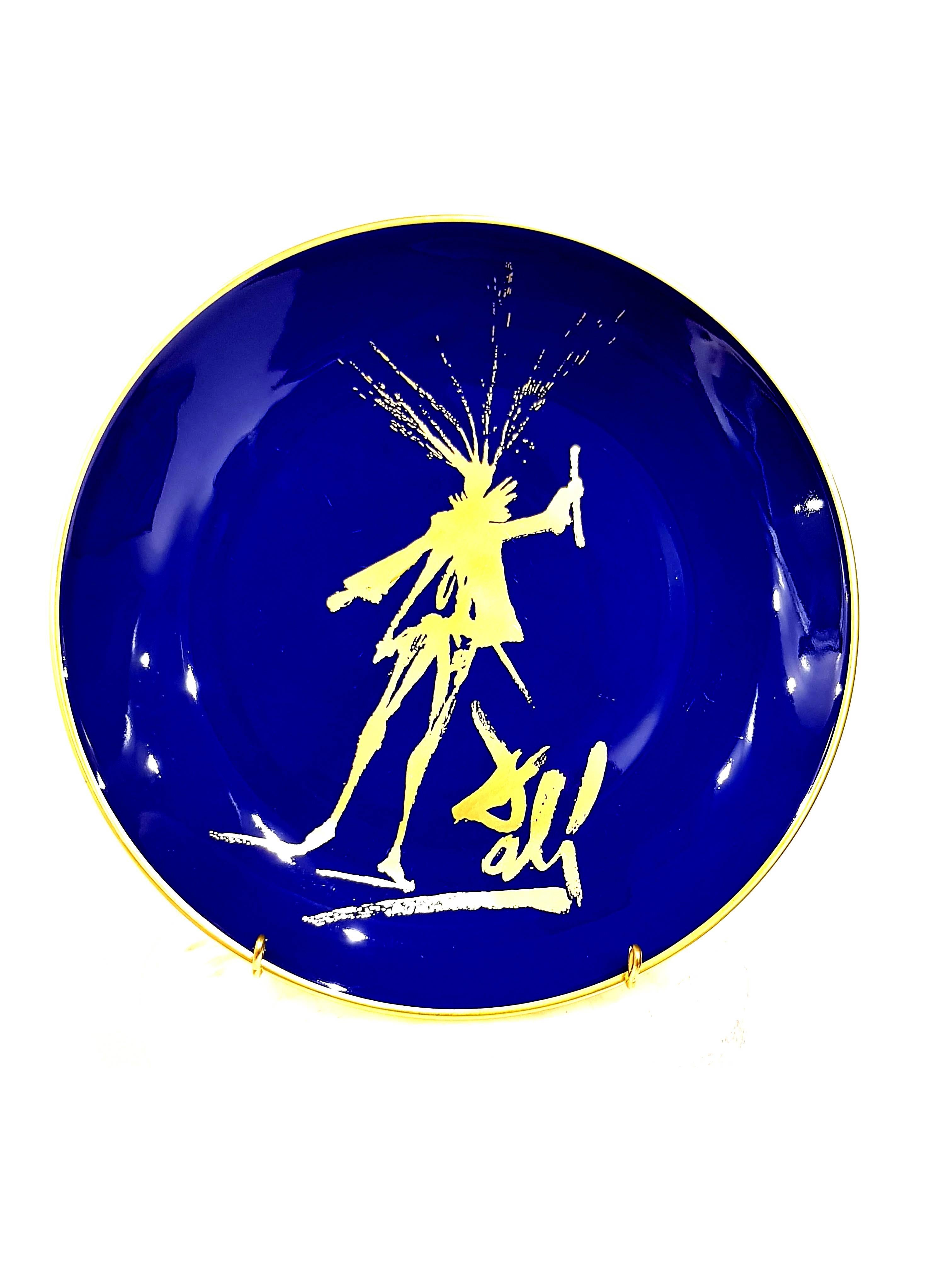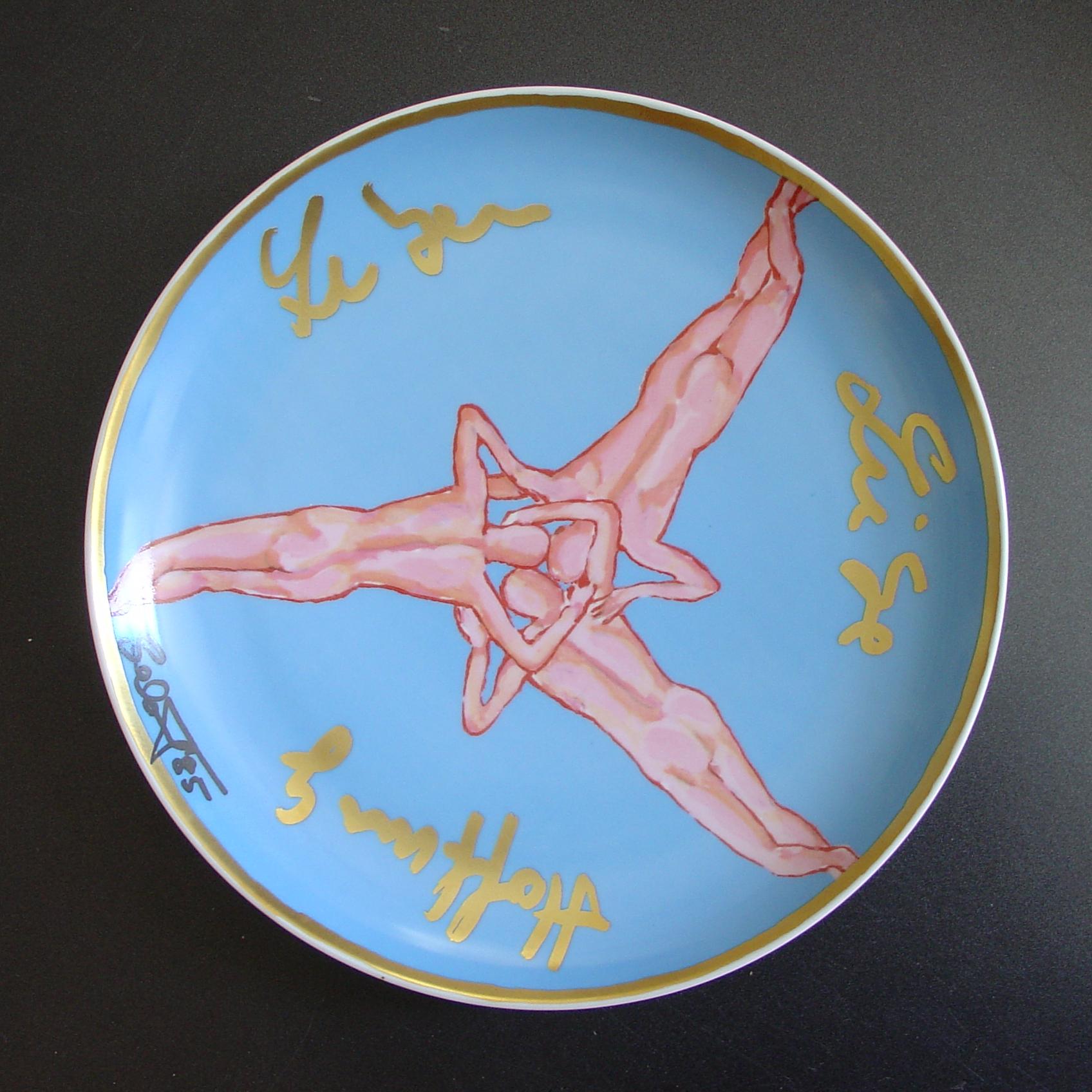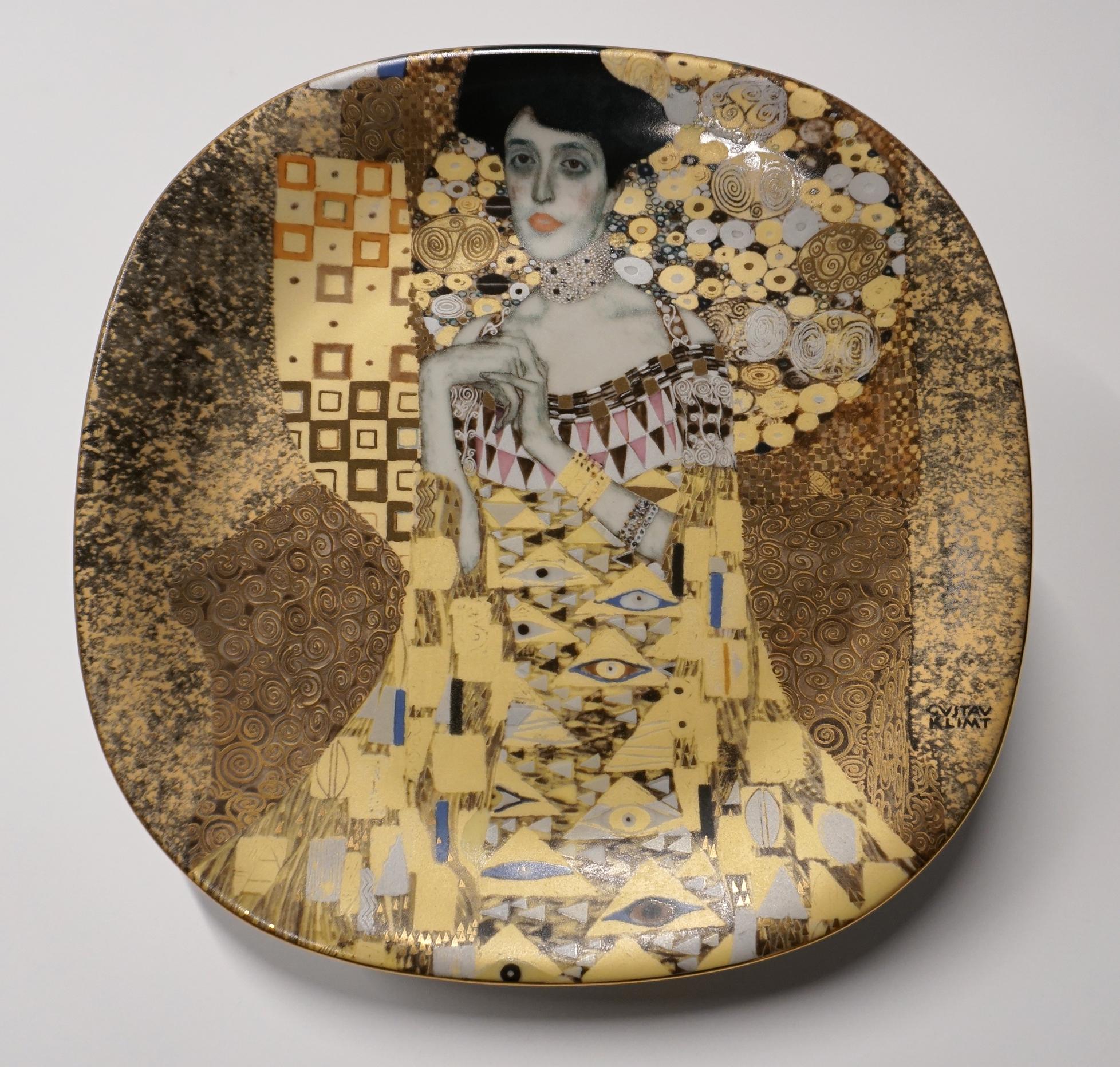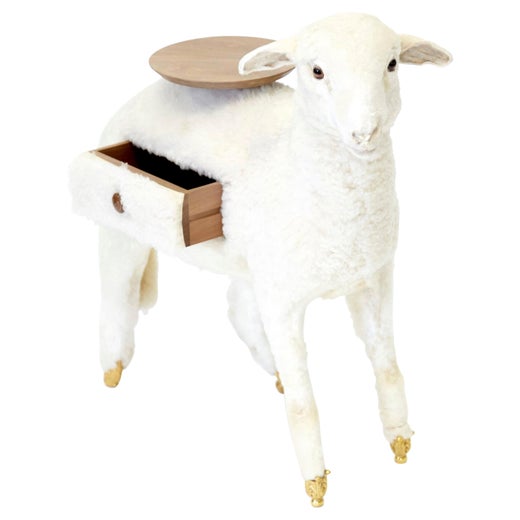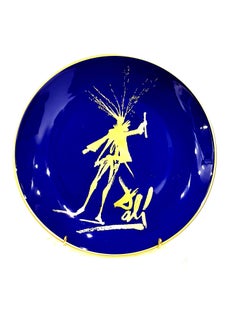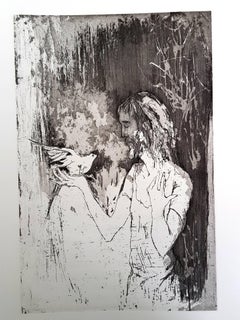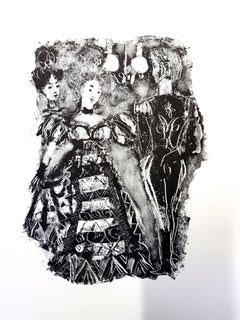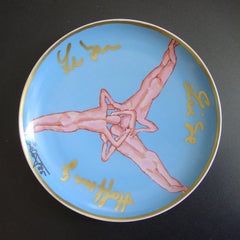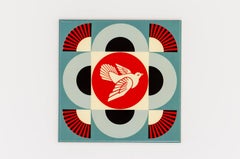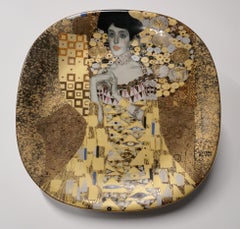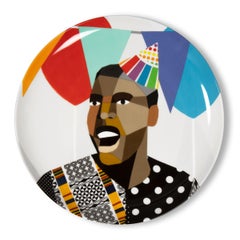Items Similar to Venus - Limoges Porcelain Blue and Gold
Want more images or videos?
Request additional images or videos from the seller
1 of 10
(after) Salvador DaliVenus - Limoges Porcelain Blue and Gold1967
1967
About the Item
Limoges porcelain in "Bleu de Sèvres" and gold.
Artist: Salvador Dali
Exclusive limited edition to 2000 copies "Raynaud & Co. Limoges", France, 1968.
"Silhouette de Faust" drawn by Salvador Dalí. Print signed.
Plate Signed in the back of the plate
Dimensions: Diameter: 26 cm
Edited by Salins Earthenware
Sold in its original box
The company "Raynaud-Limoges" specialized in the production of porcelain products in small runs, among the company's customers - crowned people and representatives of the old aristocratic families of Europe.
Dali - the Prodigy Child without an Exam.
Salvador Dali was born as the son of a prestigious notary in the small town of Figueras in Northern Spain. His talent as an artist showed at an early age and Salvador Felipe Jacinto Dali received his first drawing lessons when he was ten years old. His art teachers were a then well known Spanish impressionist painter, Ramon Pichot and later an art professor at the Municipal Drawing School. In 1923 his father bought his son his first printing press.
Dali began to study art at the Royal Academy of Art in Madrid. He was expelled twice and never took the final examinations. His opinion was that he was more qualified than those who should have examined him.
In 1928 Dali went to Paris where he met the Spanish painters Pablo Picasso and Joan Miro. He established himself as the principal figure of a group of surrealist artists grouped around Andre Breton, who was something like the theoretical "schoolmaster" of surrealism. Years later Breton turned away from Dali accusing him of support of fascism, excessive self-presentation and financial greediness.
By 1929 Dali had found his personal style that should make him famous the world of the unconscious that is recalled during our dreams. The surrealist theory is based on the theories of the psychologist Dr. Sigmund Freud. Recurring images of burning giraffes and melting watches became the artist's surrealist trademarks. His great craftsmanship allowed him to execute his paintings in a nearly photo-realistic style. No wonder that the artist was a great admirer of the Italian Renaissance painter Raphael.
Salvador Dali and Gala.
Meeting Gala was the most important event in the artist's life and decisive for his future career. She was a Russian immigrant and ten years older than Dali. When he met her, she was married to Paul Eluard.
Gala decided to stay with Dali. She became his companion, his muse, his sexual partner, his model in numerous art works and his business manager. For him she was everything. Most of all Gala was a stabilizing factor in his life. And she managed his success in the 1930s with exhibitions in Europe and the United States.
Gala was legally divorced from her husband in 1932. In 1934 Dali and Gala were married in a civil ceremony in Paris and in 1958 in church after Gala's former husband had died in 1952. However from around 1965 on, the couple was seen less frequently together. But Gala continued to manage Dali's business affairs.
1933 Salvador Dali had his first one-man show in New York. One year later he visited the U.S. for the first time supported by a loan of US$500 from Pablo Picasso. To evade World War II, Dali chose the U.S.A. as his permanent residence in 1940. He had a series of spectacular exhibitions, among others a great retrospective at the Museum of Modern Art in New York.
Besides creating a number of great paintings, Dali caused the attention of the media by playing the role of a surrealist clown. He made a lot of money and was contemptuously nicknamed Avida Dollars (greedy for dollars) by Andre Breton.
Dali became the darling of the American High Society. Celebrities like Jack Warner or Helena Rubinstein gave him commissions for portraits. His art works became a popular trademark and besides painting he pursued other activities - jewelry and clothing designs for Coco Chanel or film making with Alfred Hitchcock.
The Classic Period After World War II
In 1948 Dali and Gala returned to Europe, spending most of their time either in their residence in Lligat or Spain or in Paris or France or in New York. Dali developed a lively interest in science, religion and history. He integrated things into his art that he had picked up from popular science magazines.
Another source of inspiration were the great classical masters of painting like Raphael, Velasquez or the French painter Ingres. The artist commented his shift in style with the words: "To be a surrealist forever is like spending your life painting nothing but eyes and noses."
In 1958 the artist began his series of large sized history paintings. He painted one monumental painting every year during the summer months in Lligat. The most famous one, The Discovery of America by Christopher Columbus, can be seen at the Dali Museum in St. Petersburg in Florida. It is breath-taking. The artist's late art works combine more than ever his perfect and meticulous painting technique with his fantastic and limitless imaginations.
Salvador Dali is the only known artist who had two museums dedicated exclusively to his works at lifetime.
Dali Museum in St. Petersburg, Florida
The Dali Museum in St. Petersburg in Florida or U.S.A. was founded in 1971 by the Dali collector A. Reynolds Morse and his wife Eleanor. The collection was first exhibited in a building adjacent to their home in Cleveland/Ohio.
In 1982, the museum was moved to St. Petersburg in Florida. It hosts 95 oil paintings including six of Dali's eighteen large-sized historical paintings.
Dali Museum-Theater in Figueres, Spain.
The Dali Museum-Theater in Figueres, Spain was the former Municipal Theater of Figueres. In 1918, when Salvador Dali was only fourteen years old, it had shown his first public exhibition.
Since 1970 the artist had dedicated his energy to transform the former Municipal Theater into a museum and art gallery. In 1974 the Theatro Museo Dali was officially opened.
1980 Dali was forced to retire due to palsy, a motor disorder, that caused a permanent trembling and weakness of his hands. He was not able to hold a brush any more. The fact that he could not follow his vocation and passion of painting and the news of Gala's death in 1982 left him with deep depressions.
After Gala's death he moved to Pubol, a castle, he had bought and decorated for Gala. In 1984, when he was lying in bed, a fire broke out and he suffered sever burns. Two years later, a pacemaker had to be implanted.
Towards the end of his life, Dali lived in the tower of his own museum where he died on January 23, 1989 from heart failure.
- Creator:(after) Salvador Dali (1904 - 1989, Spanish)
- Creation Year:1967
- Dimensions:Height: 0.79 in (2 cm)Width: 10.24 in (26 cm)Depth: 10.24 in (26 cm)
- Medium:
- Movement & Style:
- Period:
- Condition:
- Gallery Location:Collonge Bellerive, Geneve, CH
- Reference Number:1stDibs: LU16122565451
(after) Salvador Dali
Salvador Dali (1904 – 1989) was a Spanish surrealist artist renowned for his technical skill, precise draftsmanship and the striking and bizarre images in his work. Born in Figueres, Catalonia, Dali received his formal education in fine arts in Madrid. Influenced by Impressionism and the Renaissance masters from a young age, he became increasingly attracted to Cubism and avant-garde movements. He moved closer to Surrealism in the late 1920s and joined the Surrealist group in 1929, soon becoming one of its leading exponents. His best-known work, The Persistence of Memory, was completed in August 1931, and is one of the most famous Surrealist paintings. Dali lived in France throughout the Spanish Civil War (1936 to 1939) before leaving for the United States in 1940 where he achieved commercial success. He returned to Spain in 1948 where he developed his "nuclear mysticism" style, based on his interest in classicism, mysticism and recent scientific developments. Dali's artistic repertoire included painting, graphic arts, film, sculpture, design and photography, at times in collaboration with other artists. He also wrote fiction, poetry, autobiography, essays and criticism. Major themes in his work include dreams, the subconscious, sexuality, religion, science and his closest personal relationships. Some trends in Dali's work that would continue throughout his life were already evident in the 1920s. Dali was influenced by many styles of art, ranging from the most academically classic, to the most cutting-edge avant-garde. His classical influences included Raphael, Bronzino, Francisco de Zurbaran, Vermeer and Velazquez. Exhibitions of his works attracted much attention and a mixture of praise and puzzled debate from critic
About the Seller
4.9
Platinum Seller
Premium sellers with a 4.7+ rating and 24-hour response times
Established in 2015
1stDibs seller since 2015
952 sales on 1stDibs
Typical response time: <1 hour
- ShippingRetrieving quote...Shipping from: Collonge Bellerive, Geneve, Switzerland
- Return Policy
Authenticity Guarantee
In the unlikely event there’s an issue with an item’s authenticity, contact us within 1 year for a full refund. DetailsMoney-Back Guarantee
If your item is not as described, is damaged in transit, or does not arrive, contact us within 7 days for a full refund. Details24-Hour Cancellation
You have a 24-hour grace period in which to reconsider your purchase, with no questions asked.Vetted Professional Sellers
Our world-class sellers must adhere to strict standards for service and quality, maintaining the integrity of our listings.Price-Match Guarantee
If you find that a seller listed the same item for a lower price elsewhere, we’ll match it.Trusted Global Delivery
Our best-in-class carrier network provides specialized shipping options worldwide, including custom delivery.More From This Seller
View AllFaust - Limoges Porcelain Blue and Gold
By (after) Salvador Dali
Located in Collonge Bellerive, Geneve, CH
Limoges porcelain in "Bleu de Sèvres" and gold.
Artist: Salvador Dali
Exclusive limited edition to 2000 copies "Raynaud & Co. Limoges", France, 1968.
"Faust" drawn by Salvador Dalí. Print signed.
Plate Signed in the back of the plate
Dimensions: Diameter: 26 cm
Edited by Salins Earthenware
Sold in its original box
The company "Raynaud-Limoges" specialized in the production of porcelain products in small runs, among the company's customers - crowned people and representatives of the old aristocratic families of Europe.
Dali - the Prodigy Child without an Exam.
Salvador Dali was born as the son of a prestigious notary in the small town of Figueras in Northern Spain. His talent as an artist showed at an early age and Salvador Felipe Jacinto Dali received his first drawing lessons when he was ten years old. His art teachers were a then well known Spanish impressionist painter, Ramon Pichot and later an art professor at the Municipal Drawing School. In 1923 his father bought his son his first printing press.
Dali began to study art at the Royal Academy of Art in Madrid. He was expelled twice and never took the final examinations. His opinion was that he was more qualified than those who should have examined him.
In 1928 Dali went to Paris where he met the Spanish painters Pablo Picasso and Joan Miro. He established himself as the principal figure of a group of surrealist artists grouped around Andre Breton, who was something like the theoretical "schoolmaster" of surrealism. Years later Breton turned away from Dali accusing him of support of fascism, excessive self-presentation and financial greediness.
By 1929 Dali had found his personal style that should make him famous the world of the unconscious that is recalled during our dreams. The surrealist theory is based on the theories of the psychologist Dr. Sigmund Freud. Recurring images of burning giraffes and melting watches became the artist's surrealist trademarks. His great craftsmanship allowed him to execute his paintings in a nearly photo-realistic style. No wonder that the artist was a great admirer of the Italian Renaissance painter Raphael.
Salvador Dali and Gala.
Meeting Gala was the most important event in the artist's life and decisive for his future career. She was a Russian immigrant and ten years older than Dali. When he met her, she was married to Paul Eluard.
Gala decided to stay with Dali. She became his companion, his muse, his sexual partner, his model in numerous art works and his business manager. For him she was everything. Most of all Gala was a stabilizing factor in his life. And she managed his success in the 1930s with exhibitions in Europe and the United States.
Gala was legally divorced from her husband in 1932. In 1934 Dali and Gala were married in a civil ceremony...
Category
1960s Modern Mixed Media
Materials
Porcelain
Jean Picart Le Doux - Sunshine - Original Salins Earthenware
By Jean Picart Le Doux
Located in Collonge Bellerive, Geneve, CH
Original Salins Earthenware Plate
Artist: Jean Picart Le Doux
Title: Sunshine
Signed in the back of the plate
Dimensions: Diameter: 24 cm
Edited by Salins Earthenware
Jean Picart le Doux, French (1902 - 1982)
Jean Picart Le Doux, born in Paris January 31, 1902 and died in 1982, was a French painter and painter-cartonnier the revival of contemporary tapestry.
He is the son of the painter Charles Picart Le Doux (1881-1959).
Without specialized training, he made his debut in bookbinding and publishing, and then he turned to advertising and graphic arts and publishing his first works in 1935. His first tapestry dating from 1943 after winning the Grand Prix of the theater poster exhibition in the imaging.
He met Jean Lurçat and, with Marc Saint-Saëns, gather around him in 1947 for the Association of painters cardboard tapestry.
In 1950, he projects the idea of the Alliance Graphique Internationale, during the meeting with exhibitors of an exhibition of their work in Basel, two other French designers Jean Jacques Colin and Nathan, and two graphic designers Swiss, Fritz Buhler and Donald Brown...
Category
1960s Modern Mixed Media
Jean Jansem - Saint- Original Etching
By Jean Jansem
Located in Collonge Bellerive, Geneve, CH
Jean Jansem - Original Etching
Title: Saint
Dimensions: 40 x 30 cm
Edition of 175
Paper: vélin de Rives
1974
Jean Jansem was born in 1920 at Seuleuze in Asia Minor and spent his ear...
Category
1970s Modern Figurative Prints
Materials
Etching
$418 Sale Price
28% Off
Antoni Clavé - Original Lithograph - For Pushkin's Queen of Spades
By Antoni Clavé
Located in Collonge Bellerive, Geneve, CH
Antoni Clavé - Original Lithograph - For Alexander Pushkin's Queen of Spades
Dimensions: 325 x 247 mm.
1946
Original lithograph of Antoni Clavé
Edition: 300
The Queen of Spades. Tr...
Category
1940s Modern Figurative Prints
Materials
Lithograph
$487 Sale Price
30% Off
Antoni Clavé - Original Lithograph - For Pushkin's Queen of Spades
By Antoni Clavé
Located in Collonge Bellerive, Geneve, CH
Antoni Clavé - Original Lithograph - For Alexander Pushkin's Queen of Spades
Dimensions: 325 x 247 mm.
1946
Original lithograph of Antoni Clavé
Edition: 300
The Queen of Spades. Tr...
Category
1940s Modern Portrait Prints
Materials
Lithograph
$487 Sale Price
30% Off
Antoni Clavé - Original Lithograph - For Pushkin's Queen of Spades
By Antoni Clavé
Located in Collonge Bellerive, Geneve, CH
Antoni Clavé - Original Lithograph - For Alexander Pushkin's Queen of Spades
Dimensions: 325 x 247 mm.
1946
Original lithograph of Antoni Clavé
Editio...
Category
1940s Modern Portrait Prints
Materials
Lithograph
$488 Sale Price
30% Off
You May Also Like
Rosenthal plate
Located in New York, NY
SALOME
Rosenthal Plate, 1985
porcelain
10½ in. diam. 26 cm.
Edition 143/3000
signed and dated on lower right
Category
1980s Modern Figurative Prints
Materials
Porcelain
SHEPARD FAIREY - GEOMETRIC DOVE (BLUE TILE), urban art, tile, craft
By Shepard Fairey
Located in Madrid, Madrid
SHEPARD FAIREY - GEOMETRIC DOVE (BLUE TILE)
Date of creation: 2021
Medium: Digital print on tile with cork base
Edition: 225
Size: 15 x 15 cm
Condition: Brand new in mint condition
...
Category
2010s Street Art Figurative Prints
Materials
Enamel
PORTRAIT OF ADELE BLOCH-BAUER plate
By (after) Gustav Klimt
Located in New York, NY
Artist Reproduction plate. Edition 1401A
Reihe "Gustav Klimt – Phantastische Meisterwerke" mit einem diagonalen Durchmesser von 22 cm und einer Goldumrandung an. Es handelt sich dabei um die Ausgabe "...." aus dem Jahr 1990, Teller-Nr. ?, die als Reproduktion im Auftrag des Hauses Lilien Porzellan...
Category
1990s Art Deco Figurative Prints
Materials
Porcelain
Derrick Adams, We Came to Party and Plan 38 - Limited Edition Plate
Located in Hamburg, DE
Derrick Adams (American, b. 1970)
We Came to Party and Plan 38, 2022
Medium: Porcelain plate (fine bone china)
Dimensions: 26.7 cm diameter (10 1/2 in)
Edition of 250: Printed signat...
Category
21st Century and Contemporary Pop Art Figurative Prints
Materials
Porcelain
Flowers, After Andy Warhol -Pop Art, Enamel on porcelain, Contemporary, Edition
By Andy Warhol
Located in Zug, CH
Andy Warhol
Flowers, 1980
Enamel on porcelain
Edition of 49
51 x 51 x 2 cm (20 x 20 x 0.7 in)
In wooden box.
Screenprint on porcelain in wooden frame
signed in the glazing, numbered on label verso
In mind condition.
The piece is offered unframed.
Throughout art history, the flower and its symbolism have been a subject matter for many renowned artists. Andy Warhol explored the qualities of the flower image through his Pop Art prism in the Flower series of 1964, thus creating cartoon-like symbols that would be instantly recognised.
The 1964 Flower series became one of his most iconic and successful works.
Based on a discovered photograph of hibiscus blossoms, Warhol drenched the flowers’ floppy shapes with a variation of vibrant colours, transforming them into psychedelic indoor décor. Playing with traditional art historical themes, Andy Warhol gave a particular twist to this historically accepted symbol of life. The electric colours of his flowers, drawn from a darker and rich undergrowth background might be the indicator of an extreme vision of life, a life lived on the edge.
Andy Warhol (1928-1987) was an American artist, a leading figure of the Pop Art movement. Using a variety of media materials from photographs up to computer-generated art, Warhol's works explore the relationship between artistic expression, celebrity, culture and advertisement that flourished by the 1960s. Emerging from the poverty and obscurity of an Eastern European immigrant family in Pittsburgh, Warhol became a charismatic magnet for bohemian New York. In 1960, he began to produce his first canvases depicting Popeye and Dick Tracy. After Marilyn Monroe’s death in August 1962, he started working from snapshots of the star’s already legendary face, which had been widely distributed by the world’s press. His choice of subjects clearly relates to an obsession with demise – his Marilyns, his Ten Lizies (created when the actress Elizabeth Taylor was seriously ill), and also his Elvis. Part of the “Death and Disaster” series, Andy Warhol´s...
Category
20th Century Pop Art Figurative Prints
Materials
Enamel
Philip Guston, Untitled - Limited Edition Plate, Contemporary Art
Located in Hamburg, DE
Philip Guston (American, b. 1970)
Untitled, 2023
Medium: Porcelain plate (fine bone china)
Dimensions: 26.7 cm diameter (10 1/2 in)
Edition of 250: Printed signature and edition deta...
Category
21st Century and Contemporary Contemporary Figurative Prints
Materials
Porcelain
